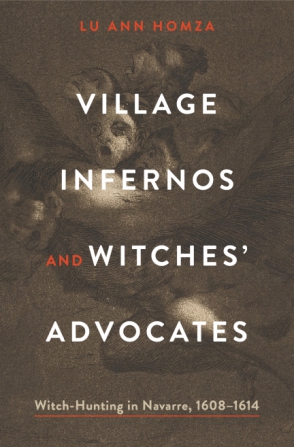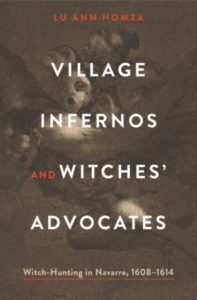
Village Infernos and Witches’ Advocates: Witch-hunting in Navarre, 1608-1614 by Lu Ann Homza

The infamous witch-hunts of early modern Navarre are brought into a fresh and multi-faceted clarity in a stunning book by Lu Ann Homza. Village Infernos and Witches’ Advocates: Witch-hunting in Navarre, 1608-1614 revises many of the accepted ideas about the trials that occurred there at the beginning of the seventeenth century, including who the main actors were and how the court systems upheld, or at times failed to uphold, justice for accused witches according to the policies of the Inquisition. Homza presents important archival discoveries that illuminate the fractured legal systems of the Inquisition, and perhaps, most importantly, the voices of many children and teenagers who experienced the witch-hunts on the ground. The goal of the work is two-fold: first, to present new sources that shed light on the role of children in witchcraft cases in Navarre, and second, to demonstrate the complexities of the Inquisition system with regard to how witches were persecuted in the various courts. Her innovative work combines the records of the Inquisition with new sources from both secular and religious courts, as well as notarial and census records, to create a more cohesive picture of how the witch-hunts played out in seventeenth-century Navarre and provide a glimpse into the beliefs, fears, and practices surrounding early modern European witchcraft.
Homza’s introduction will prove useful to students making an initial foray into the world of early modern witchcraft, as it takes the reader through the foundation of the Inquisition and its initial goal of rooting out the crime of heresy in all forms, including blasphemy, adultery, and witchcraft. The author then presents a valuable journey through the process of a witchcraft accusation in early modern Navarre, demonstrating how an inquisitor could pursue defendants in various ways, the search for proof of guilt, the arrest of the accused, and the numerous possible outcomes of a trial. Homza’s brief but detailed presentation of the state of witchcraft studies points to the developments in the field since the 1960s that have tended to focus more on the role of the inquisitors, due mostly to the scarcity of sources accounting for other voices. This is where Village Infernos and Witches’ Advocates makes an invaluable contribution to the field. Indeedd, the new evidence Homza has unearthed in the notarial documents in the Archivo Real y General de Navarra and the Archivo Diocesano de Pamplona highlights the children, men, and women “who suffered from, engaged in, and witnessed the miseries of witch-hunting,” whether as accused victims or litigants, helping to reveal the “emotional logic, legal reasoning, and religious and social values of a whole range of hitherto unknown and unheard actors…” [1]
These actors are explored in the first chapter, titled “Trauma,” which provides insight into the experiences of these people, plunging the reader into a comprehensive re-telling of the emotional and physical trauma that many accused witches experienced. The witches in Navarre were accused of the stereotypical crimes associated with witchcraft across Europe: poisoning livestock, ruining crops, or stealing children from their beds; but the Navarrese Inquisitors also raised an unprecedented number of accusations of cannibalism and harm inflicted upon small children across communities. Based on legal sources, Homza demonstrates how communities in Navarre interacted through these accusations of witchcraft, as well as how the magistrates attempted to manage the rapidly rising number of allegations the inquisitors were fielding. The book particularly shines in reminding the reader of the high stakes and devastating effects that a witchcraft accusation could have on a community, often for both the accused and the accuser. For historians of witchcraft, an overturned death sentence commuted to banishment by an appeals court can at times be read as legislative leniency, but Homza points to the records from Pamplona to remind readers that even an accusation or banishment could lead to death or personal injury.[2] Through her descriptions of the physical and emotional damage that witchcraft trials caused among the Navarrese, Homza succeeds in painting a picture of the criminal terrain of seventeenth-century Navarre, portraying the ways in which witchcraft accusations were part of a larger heretical sphere, often combined with charges of slander (injurias).
Homza’s work elaborates on what could cause witchcraft allegations among communities, expanding upon the generally accepted idea that many early modern witchcraft accusations emerged out of social tensions, such as those based on the desire for vengeance or long-standing ill reputations. In developing this thesis, Homza demonstrates how parents addressed allegations of witchcraft in the face of religious fervor or fear for their child’s salvation. In this respect, Village Infernos also constitutes a useful contribution to the history of the special role that children played in the court systems at that time. Across early modern Europe, different legal systems had overlapping and complex laws about the credibility of children as witnesses in cases of witchcraft and slander, which were often intimately linked; in Navarre, “children and teenagers who accused peers and adults of witchcraft were not charged with slander, and there was no legal mechanism to stop them from continuing to accuse.”[3] Homza demonstrates that this nebulous legal practice allowed children to accuse adults of being witches quite often and that the children could recount where they had been taken by adult witches, usually in lurid details. The focus on children in cases of witchcraft, argues Homza, helps reveal important facts not only about early modern beliefs in witchcraft, but also about the limits of justice, familial values, and identity. This focus also brings attention to further work to be done by scholars of witchcraft and demonology concerning the identity of “witches” and its connection to adolescence.
In the course of the book, the author shifts the focus from the accused witches to the inquisitors, examining how the latter came to their decisions and highlighting the important fact that the Inquisition was not a monolithic institution that handed down authoritative “justice” in broad, absolute strokes. In reality, the Inquisition was an amalgamation of overlapping jurisdictions and fractured power structures, which resulted in a confusing constellation of laws and procedure that could vary from court to court and from inquisitor to inquisitor. Focusing on the year 1611, when attempts to end the witch-hunts were starting to gain momentum, Homza points to the unusual collaboration between the inquisitor-general and the bishop of Pamplona, as well as to the role of the secular courts in these attempts to reconcile witches who had confessed and bring them back into the fold. Building on current trends in demonological historiography, Homza presents the reader with examples of the intellectual debates surrounding witchcraft in the early seventeenth century, examining the relationship between the Inquisitors Becerra, Valle, and Salazar, and their very public disagreements over their personal trials with witches. The book thus is useful for scholars of demonology in that it incorporates new evidence that points to the competitiveness of these magistrates, their triumphs and failures, as well as the inner-workings of their tribunals, including the particularly interesting role of notaries and their “delinquencies.” Homza has unearthed evidence of notaries participating in rampant absenteeism, double dipping into fees and bribes, and commonly neglecting to record crucial information during witchcraft trials. All of this information supports the larger question of Homza’s work: Who was accused of witchcraft in Navarre, and how did various courts address these cases?
Homza’s clear prose and detailed archival work weave a fascinating micro-history into the larger narrative of the early modern witch-hunts.The author demonstrates how Navarrese children and teenagers worked the court systems, actively participating in the development of witchcraft beliefs and the ever-changing juridical practices of the Inquisition. These young people demonstrated faith in the legal system, even though many times that system was fractured and let them down. This book also points to the necessity for witchcraft scholars to focus on local witch-hunts and inspires readers to delve into the archive and search for unconventional sources that could help bring into better focus the quotidian nature of early modern witchcraft in Europe. Overall, Village Infernos and Witches’ Advocates will prove a useful text for undergraduate educators seeking to introduce students to the complex nature of witchcraft as a religious, social, and legal issue. It will also serve as an inspiring work to advanced scholars of witchcraft, as it demonstrates the power of creative and determined source work.
Chloé Roberts is a PhD candidate at the University of California Santa Barbara where she studies the history of witchcraft, demonic possession, magic, and ghosts in the early modern world. She was a Fulbright fellow for the 2021-2022 academic year, and is currently completing research in France.
Village Infernos and Witches’ Advocates: Witch-hunting in Navarre, 1608-1614
By Lu Ann Homza
Publisher: Pennsylvania State University Press
Hardcover / 260 pages / 2022
ISBN: 978-0-271-09181-5
[1] Lu Ann Homza, Village Infernos and Witches’ Advocates: Witch-hunting in Navarre, 1608-1614, (University Press: Pennsylvania State University Press, 2021), 9.
[2] Homza, Village Infernos and Witches’ Advocates, 20.
[3] Ibid., 22.
Published on February 21, 2023.




